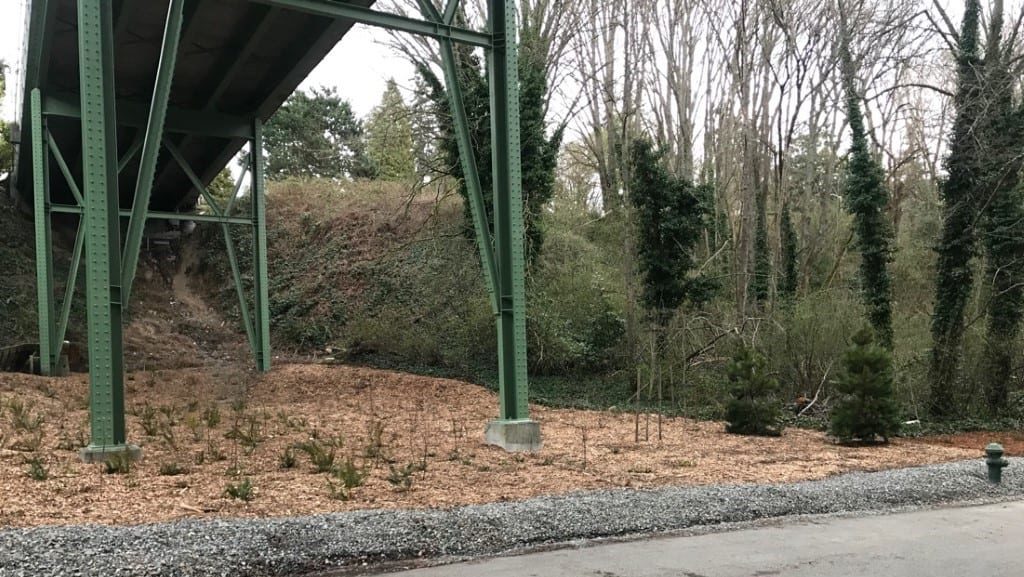 New steel plates on the W Howe Street Bridge are designed to reinforce the existing structure during a seismic event.
New steel plates on the W Howe Street Bridge are designed to reinforce the existing structure during a seismic event. This marks the 32nd seismic retrofit project completed since our Bridge Seismic Retrofit Program began 30 years ago.
The word seismic means vibration of the earth and its crust – in other words, earthquakes!
Powerful earthquakes are a real threat to Seattle, and the surrounding region, and the City of Seattle is working to be prepared for the next big one. In fact, we’re a national leader in planning for seismic events and have worked with industry experts to develop our approach to our bridge seismic retrofit policy. We continually update our standards and practices as technology evolves.
Safety for the traveling public is our number one priority. Every bridge is built to the earthquake standards of the time it is designed and receives ongoing maintenance.
Our bridge seismic retrofit program (currently funded by the Levy to Move Seattle!) is one type of investment which goes above and beyond basic maintenance to bring sturdy but older bridges up to modern standards. The program is implemented in tandem with the basic bridge maintenance, regular inspections, monitoring, preservation, and repairs we perform continually to keep bridges safe.
The W Howe St Bridge is an older bridge constructed in 1946 – prior to the modern seismic design code.
The concrete and steel bridge connects W Howe St over a deep ravine at the north end of Magnolia Park in the Magnolia neighborhood of Seattle.
Funded by the voter-approved Move Seattle Levy, we completed several modifications to seismically strengthen the bridge and reduce vulnerability during an earthquake.

Here’s a look at what we did:

We added steel reinforcement to strengthen existing structure.
Here, you’re looking at a crew member installing a grey steel plate designed to reinforce the existing green steel column during an earthquake. We used this technique throughout the bridge to strengthen the bridge’s crossbeams, columns, and arches.
Once all the streel plates were installed and the retrofit work was complete, we gave the bridge a fresh coat of green paint that will help prevent rust and extend the life of the bridge. The painting was funded in part by the City’s Bridge Painting Program, which is another maintenance program that funds preventative maintenance work.

We replaced expansion joints and bearings that help control movement and reduce stress on the structure.
Pictured above, crew members install a new expansion joint at the east end of the bridge to help with the bridge movement during an earthquake.
We also replaced the old rocker bearings with new elastomeric bearings to allow the bridge to expand and contract with temperature fluctuations. The bearings (not pictured) are on the underside of the bridge deck and connect it to the bridge support piers.

We added concrete support structures to enhance safety if the bridge moves during an earthquake.
Here, you’re looking at the underside of the bridge where the steel diagonal bracing connect to the steel girders that run the length of the bridge. We installed concrete blocks, called catcher blocks, that minimizes the probability that the steel girders will slide off the bearing seat of the support piers if the structure moves during an earthquake. We also repaired cracks in existing concrete structures to extend the life of the bridge.

After the bridge retrofit construction was complete, we restored the surrounding slope and landscaping that was disturbed in order to facilitate access to the worksite.
We want to give a special shoutout to the neighbors of this project for their patience and cooperation during construction over the past year.
Nine more bridges across the city are on track to receive seismic retrofits by 2025!
The Move Seattle Levy, ending in 2025, provides funding for the current phase of our bridge seismic retrofit program and will fund earthquake improvements on 11 bridges throughout the city – these 11 include the W Howe Street Bridge and the Cowen Park Bridge retrofit completed in 2020
The bridge seismic retrofit program isn’t the only way that we take care of our structures.
Taking care of our aging bridges is important, and seismic retrofits are one of many ways that we do this. Here are some examples of other ways that we’re taking care of our assets beyond the seismic retrofit program:
- Full Replacements: Right now, we’re completely rebuilding the Fairview Ave N Bridge which was the city’s last wooden bridge on a major road and had been rated in poor condition. The new bridge will be built to modern earthquake standards, but this is in addition to the seismic retrofit program because the work goes way beyond just a seismic retrofit. In fact, the Fairview Bridge recently was awarded with the American Council of Engineering Companies Silver Award.
- Repairs / Rehabilitation: Not only are we currently investing in repairing the West Seattle High-Rise Bridge, we’re also making proactive investments in the West Seattle Low Bridge to make sure that we can count on it to remain in good shape for a long time.
- Maintenance: The seismic retrofit program is separate (above and beyond) from all the basic bridge maintenance, regular inspections, monitoring, preservation, and repairs which we perform continually to keep bridges safe and stable.
- Beyond Bridges: In addition to caring for 124 bridges, SDOT owns nearly 1,500 structures like retaining walls, stairways, and underground support walls which require ongoing maintenance and investment. For example, the City has invested in rebuilding the Elliot Bay Seawall which would support the entire central waterfront in the event of a major earthquake.

